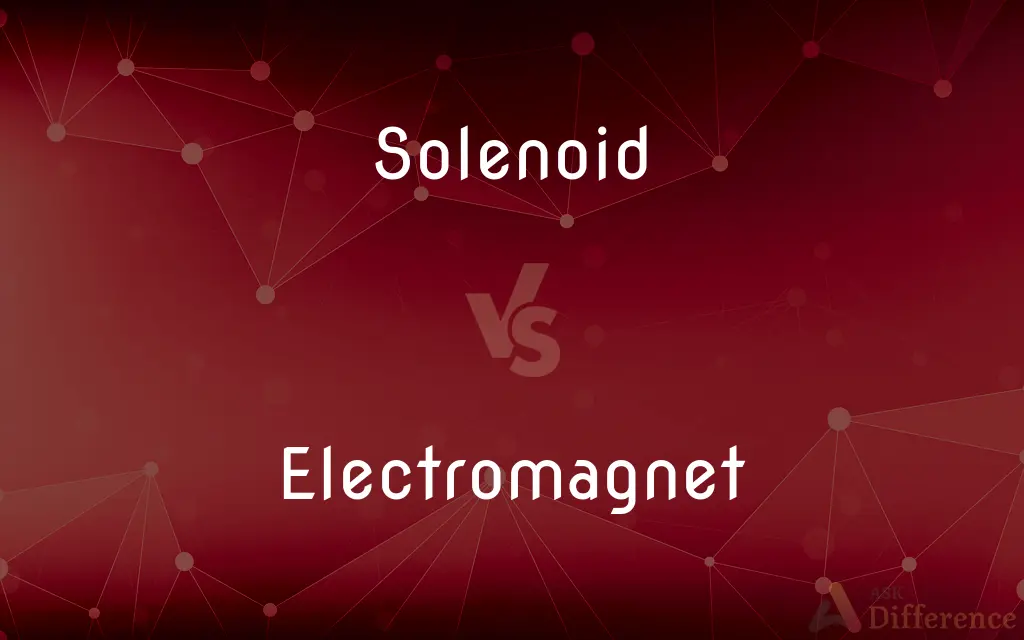Solenoid vs. Electromagnet — What's the Difference?
Edited by Tayyaba Rehman — By Fiza Rafique — Updated on March 15, 2024
A solenoid is a coil of wire designed to create a magnetic field when electric current passes through it, while an electromagnet is any magnet whose magnetic field is produced by an electric current, which often includes solenoids as a component.

Difference Between Solenoid and Electromagnet
Table of Contents
ADVERTISEMENT
Key Differences
A solenoid is specifically a type of electromagnet designed as a long, helical coil of wire, whose purpose is to generate a nearly uniform magnetic field within its interior when an electric current flows through it. On the other hand, an electromagnet refers more broadly to any device that creates a magnetic field through the flow of electric current, which can include solenoids but also other configurations, such as toroidal or straight electromagnets.
The design of a solenoid focuses on creating a magnetic field that is strong and uniform within the coil, making it useful for applications like electromagnetic valves, actuators, or as the inductive component in circuits. Whereas electromagnets can be designed in various shapes and sizes depending on their intended use, such as lifting heavy magnetic materials, powering electric motors, or in magnetic separation processes.
Solenoids typically have a simple, cylindrical form, which is easy to manufacture and integrate into various devices. Electromagnets, however, can be customized into complex shapes to suit specific applications, such as wrapping around the armature of a motor or forming the core of a transformer, demonstrating a versatility in application that goes beyond the relatively focused use of solenoids.
The operation of a solenoid benefits significantly from its design, as the length of the coil and the number of turns directly influence the strength and uniformity of the magnetic field inside. In contrast, the strength of an electromagnet is determined by factors like the core material, the current through the coil, and the coil's turns, allowing for a broader range of magnetic field strengths and characteristics.
While solenoids are often used where precise linear motion is required, as in solenoid valves or linear actuators, electromagnets find application in a wider array of devices and machinery, including electric motors, magnetic cranes, MRI machines, and more. This distinction highlights the solenoid's role as a specialized component within the broader category of electromagnets.
ADVERTISEMENT
Comparison Chart
Definition
Coil of wire creating a magnetic field when electrified
Magnet powered by electric current
Design
Long, helical coil
Various shapes and configurations
Primary Use
Generating uniform magnetic fields
Wide range of applications
Shape and Complexity
Typically simple and cylindrical
Can be complex and application-specific
Applications
Valves, actuators, circuits
Motors, lifting, MRI machines
Compare with Definitions
Solenoid
Coil design.
The solenoid in the door lock actuates the locking mechanism when energized.
Electromagnet
Varied configurations.
Electromagnets in scrap yards lift heavy metal objects, showcasing their strength and versatility.
Solenoid
Linear motion.
Solenoids are commonly used in pinball machines to produce quick, precise movements.
Electromagnet
Customizable strength.
The magnetic field strength of an electromagnet can be adjusted by varying the electric current.
Solenoid
Simple structure.
The simplicity of a solenoid's design facilitates its integration into various devices.
Electromagnet
Versatile use.
Electromagnets play a key role in medical imaging devices like MRI machines, demonstrating their broad applicability.
Solenoid
Uniform magnetic field.
The magnetic field inside the solenoid remains consistent, making it ideal for precision applications.
Electromagnet
Dependence on core material.
Using an iron core in an electromagnet significantly increases its magnetic field strength.
Solenoid
Electrical component.
Solenoids can also function as inductive components in electrical circuits, storing energy.
Electromagnet
Diverse applications.
Electromagnets are crucial in the operation of electric motors, transforming electrical energy into mechanical motion.
Solenoid
A solenoid (,) is a type of electromagnet, the purpose of which is to generate a controlled magnetic field through a coil wound into a tightly packed helix. The coil can be arranged to produce a uniform magnetic field in a volume of space when an electric current is passed through it.
Electromagnet
An electromagnet is a type of magnet in which the magnetic field is produced by an electric current. Electromagnets usually consist of wire wound into a coil.
Solenoid
A current-carrying coil of wire that acts like a magnet when a current passes through it.
Electromagnet
A magnet consisting of a coil of insulated wire, usually wrapped around a steel or iron core, that is magnetized only when current flows through the wire.
Solenoid
An assembly used as a switch, consisting of a coil and a metal core free to slide along the coil axis under the influence of the magnetic field.
Electromagnet
A magnet which attracts metals only when electrically activated
Solenoid
(physics) A coil of wire that acts as a magnet when an electric current flows through it.
Electromagnet
A temporary magnet made by coiling wire around an iron core; when current flows in the coil the iron becomes a magnet
Solenoid
(engineering) An electromechanical device consisting of such a coil containing a metal core, the movement of which is controlled by the current.
Solenoid
(electronics) An electromechanical switch controlled by a solenoid; solenoid switch, relay.
Solenoid
(meteorology) The region of intersection between isobaric and isopycnal surfaces.
Solenoid
An electrodynamic spiral having the conjuctive wire turned back along its axis, so as to neutralize that component of the effect of the current which is due to the length of the spiral, and reduce the whole effect to that of a series of equal and parallel circular currents. When traversed by a current the solenoid exhibits polarity and attraction or repulsion, like a magnet.
Solenoid
A coil of wire around an iron core; becomes a magnet when current passes through the coil
Common Curiosities
Are solenoids used in everyday devices?
Solenoids are found in many everyday devices, such as door locks, appliances, and cars, where precise, controlled motion is needed.
Can solenoids create motion?
Yes, solenoids can create linear motion by exploiting the magnetic field generated within their coils to move a plunger or lever.
What is the advantage of using an electromagnet over a permanent magnet?
The main advantage of electromagnets is their controllable strength and the ability to turn them on and off, unlike permanent magnets.
How does the core material affect an electromagnet?
The core material, typically iron or steel, amplifies the magnetic field generated by the coil, making the electromagnet stronger.
What is a solenoid?
A solenoid is a coil of wire designed to produce a magnetic field when electric current is passed through it.
What makes electromagnets versatile?
Electromagnets' versatility comes from their ability to have customized shapes, strengths, and functionalities based on the application, ranging from lifting heavy metals to being used in electronic devices.
Can the strength of a solenoid be adjusted?
Yes, the strength of a solenoid's magnetic field can be adjusted by changing the current through the coil or by modifying the number of turns in the coil.
How does an electromagnet differ from a solenoid?
An electromagnet is any device that creates a magnetic field through electric current, including solenoids, which are a specific type of electromagnet designed as coils.
Why are solenoids preferred in automated systems?
Solenoids are preferred in automated systems due to their ability to provide rapid and precise linear movements, essential for actuation and control mechanisms.
What is the significance of the coil design in electromagnets?
The coil design, including its shape, size, and the number of turns, significantly impacts the strength and distribution of the magnetic field in electromagnets.
Can electromagnets be used to store information?
Yes, electromagnets are used in data storage devices, like hard drives, where magnetic fields represent binary data, allowing for the reading and writing of information.
How do electromagnets contribute to energy conversion?
Electromagnets are essential in devices like electric motors and generators, where they convert electrical energy into mechanical energy, or vice versa, through the interaction of magnetic fields.
Share Your Discovery

Previous Comparison
Machine vs. Motor
Next Comparison
Mennonites vs. HutteritesAuthor Spotlight
Written by
Fiza RafiqueFiza Rafique is a skilled content writer at AskDifference.com, where she meticulously refines and enhances written pieces. Drawing from her vast editorial expertise, Fiza ensures clarity, accuracy, and precision in every article. Passionate about language, she continually seeks to elevate the quality of content for readers worldwide.
Edited by
Tayyaba RehmanTayyaba Rehman is a distinguished writer, currently serving as a primary contributor to askdifference.com. As a researcher in semantics and etymology, Tayyaba's passion for the complexity of languages and their distinctions has found a perfect home on the platform. Tayyaba delves into the intricacies of language, distinguishing between commonly confused words and phrases, thereby providing clarity for readers worldwide.
















































